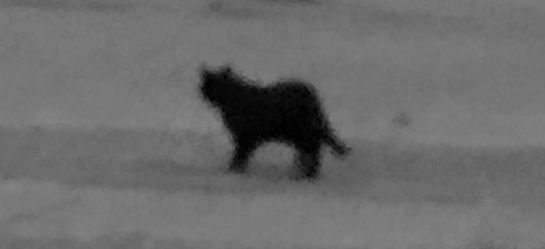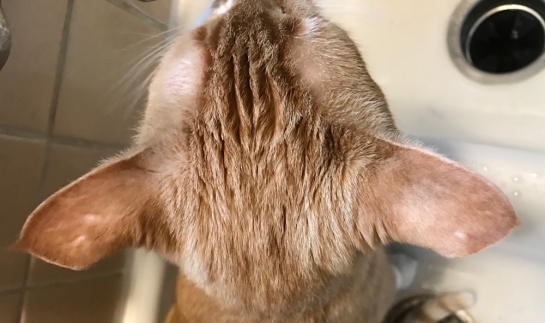By Tom Demerly for tomdemerly.com

He appeared like night smoke. Silent and sudden.
And like smoke he disappeared without a sound.
Someone’s black cat walked through our yard. It sometimes jumps on the windowsills. Nothing unusual, just a pet cat on his rounds when its owner let it outside.
Or so I thought.
After seeing the same black cat every day, whom we began calling “The Mysterious Cat”, I started paying attention to him. I had no idea I would discover an incredible, mysterious wilderness right outside my window. It’s a complex hierarchy of alpha predators, finite territories, deadly stalking and a ruthless food chain. It’s no different than the plains of Africa where majestic lions hunt in prides or the jungles of the Suriname Forest in India where Bengal tigers stalk their prey like solitary snipers. In fact, it may be even more complex because, whether we realize it or not, we are part of the food chain.
Five things helped me understand The Mysterious Cat. I watched a BBC documentary called “The Secret Life of the Cat”. It followed the hidden behavior of indoor/outdoor pet cats and revealed details about their range, territorial activity and habits. I recently saw the award-winning film, “Kedi”, about feral cats living in Istanbul, Turkey and the local populations’ reverent relationship with them since ancient times. I was reading author(s) Erin Hunter’s entertaining fiction book series, The Warriors. Erin Hunter, who is actually a group of six different authors, creates fictional feline characters divided into different categories of cats. Some are pet cats, called “kittypets”, others are solitary outdoor cats called “loners” and “rogues”. They have complex fictional societies and elaborate adventures. I was also casually keeping track of local pet cats’ behavior in the neighborhood. I would see the same cats on someone’s porch, notice their schedules and territorial behavior. And then finally, the fifth thing that got my attention:
One night The Mysterious Cat made an extraordinary visit. It stalked into our run-down outdoor back porch. A very large, solid black cat with a thick coat and sturdy legs. He skirted the crumbling brick planter wall, checked over his shoulder twice, then silently climbed in one stride up to where my girlfriend had planted catnip plants. He munched catnip for a second, and then it got weird…

Our indoor cat, Vice-Admiral Malcom Fredrick Davis III (Vice-Admiral for short), stepped up on the indoor porch windowsill. The Mysterious Cat left the catnip plant and slowly walked over to the outdoor window where the Vice-Admiral was. Glass separated the two cats. I anticipated hissing and raised fur, and then one cat would make a hasty retreat. But I was wrong.
The Vice-Admiral, a domesticated indoor “kittypet”, was intensely interested in the Mysterious Cat. He was not afraid of the Mysterious Cat, not aggressive toward him. It was as though he was fascinated, as a person might be seeing an exotic new species. The Vice-Admiral leaned forward toward the glass. The Mysterious cat climbed onto the windowsill outside. Only a thin windowpane separated the two cats. In a gesture that could only be interpreted as a form of inter-species détente, the Vice-Admiral assumed the exact same posture as the Mysterious Cat, mimicking him, side turned to him, pressing against the inside of the glass as the Mysterious Cat leaned against the outside in mirror image. It’s possible the cats could feel the warmth of each others’ bodies through the glass, the vibration from their nervous purring. It made no sense. I expected territorial behavior, meowing, hissing, arched backs. What I saw was bizarre behavior I had never seen between two domestic cats.
Because I wasn’t watching two domestic cats.

The Vice-Admiral maintains surveillance.
I wanted to know who owned the Mysterious Cat, who cared for it, where it lived and what its name is- whether it is a boy or a girl. I posted a photo of the Mysterious Cat from my smartphone on the local neighborhood web forum NextdoorNeighborhood.com. “Does Anyone Know This Awesome Black Cat?” What I learned was stunning.
The Mysterious Cat is not a domestic cat. It is a feral cat.
Feral cats are behaviorally hyper-evolved cats that appear identical to domestic cats. They live in a vast grey area between wild cats like bobcats, lynxes, panthers and cougars and stray domestic cats. They are very distant from an indoor domestic cat in behavior. They are also different than a stray domestic cat as I learned without realizing it a year earlier.
Feral cats are the alpha predators of suburbia. They are highly adapted and exhibit incredible intelligence, reasoning, and a remarkable ability to learn complex concepts quickly. They stalk, kill and enforce a ruthless command over a clearly defined territory. They sit at the top of a natural suburban food chain few people even know exists. Most of what they eat is prey they kill in their nightly hunting trips. These suburban wildcats help reduce rodent populations and control pests. They are, in a very real sense, the panthers on our porches. Feral cats seldom “convert” from being feral to becoming domestic, although this does happen occasionally. Particularly in the ruins of outer Detroit where vast areas of abandoned houses and overgrown lawns turned mini-forests are the perfect environment for a growing population of feral cats, these remarkable semi-wild cats are on the rise.

One night, after dark, I spotted the Mysterious Cat outside. The wind was east to west and the cat was headed east. My sound and scent would be masked. I followed him to wherever he was going. At first he appeared remarkably casual, walking in shadow near the center of the sidewalk at a businesslike pace. I did not know it, but I was being drawn into an ambush. At each corner he would stop and listen, look, before crossing the street. How did a cat learn to use sidewalks and crosswalks, and obey stop signs? I followed carefully, moving from concealed position to concealed position nearly a block behind him. Remarkably he did something I had learned as a member of an elite special operations unit in the military. He changed direction, circled back and checked behind him to be sure he was not being followed. And he saw me. This cat had just used tactics taught in the most sophisticated combat schools in the military. And he just used them to perform counter-surveillance on me. If Osama bin Laden had behaved like this cat, we’d still be looking for him. I was stunned. This was no one’s pet. This was a sophisticated predator.
A woman on the NextDoorNeighborhood.com forum replied to my inquiry about the Mysterious Cat. Cyndi Parrely lives on the corner two city blocks east of our house. Her garage door is always slightly open, about a foot. There is a stone statue of a cat in her garden. Visible just under her door is a small cat enclosure. The lair of the Mysterious Cat.

“I do not know if it’s a boy or girl. Can’t really get close enough. I began feeding her/him about a year ago. Very gentle but keeps her distance. Never makes a sound.”
Cyndi has defaulted to referring to the Mysterious Cat as “her”. No one knows its true gender or age. Or where it came from. But Cyndi is a kind and generous person who has made a home in her garage for the Mysterious Cat. She has entered the behavioral and food chain of the feral cat, and performs a vital function to its survival.
The Mysterious Cat would only accept food and some limited outdoor shelter from her. No petting sessions, little physical contact. “I touch her when she comes up to eat and she is fine with that. Doesn’t run away.”
Suddenly a number of mysterious puzzle pieces about local cat behavior revealed themselves. Two cats who live at the south end of the block near the entrance to the park never leave their yard. The Mysterious Cat does not permit it. He limits their territory to their own yard, chasing them back to their house if they venture outside their clearly defined territory. He allows them their yard, but no more. And his policing of the boundaries is vigilant and rough.

Young Chester, our adopted stray who lived outside much of the time before we adopted him, had three deep puncture wounds on his left ear when we got him a year or so ago. When Chester first appeared in the neighborhood right before we adopted him the Mysterious Cat had savagely enforced his territorial rule on young Chester. Even though he was no more than a kitten, Chester was a threat, a competitor for food in the Mysterious Cat’s domain. There was no room for Chester. The Mysterious Cat tried to kill him. Luckily, young Chester escaped with only minor wounds and we adopted him permanently as an indoor cat. Now he is safe.
For months Chester would sit in the window and meow a longing, urgent meow in the early morning, the time when the Mysterious Cat was most frequently seen returning to his lair. The week after the Vice-Admiral held his meeting on the back porch with the Mysterious Cat, Chester stopped meowing. He has not done it since. It’s been a week. It is as though some silent communication was passed on that Chester is off the “kill” list; the Vice-Admiral has brokered a peace treaty. Call me a crazy cat person, but this behavior is real.
Cyndi told me, “She [or he] stares at my cat through the glass door. They are both outside together at times and get along. No fights.” Cyndi told me about the Mysterious Cat’s behavior in her yard. “I try and coax her but to no avail.”
Perhaps the most remarkable part of this story is the role we humans play in the Mysterious Cat’s life. Something in us, some desire to spread kindness and safety, is leveraged by the Mysterious Cat. It is arguable who ultimately commands the neighborhood, the humans who live in the houses here, or the Mysterious Cat that can bend us to its will without making a sound.








